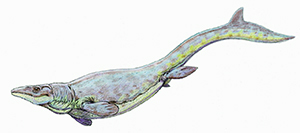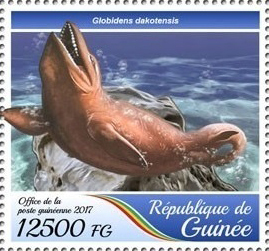Globidens dakotensis Russell, 1975

(Da: it.wikipedia.org)
Phylum: Chordata Haeckel, 1874
Subphylum: Vertebrata Cuvier, 1812
Classe: Reptilia Laurenti, 1768
Ordine: Squamata Oppel, 1811
Famiglia: Mosasauridae Gervais, 1853
Genere: Globidens Gilmore, 1912
Specie e sottospecie
Il genere annovera attualmente le seguenti specie: Globidens alabamaensis (specie tipo) Gilmore, 1912 - Globidens dakotensis Russell, 1975 - Globidens hisaensis Kaddumi, 2009 - Globidens phosphaticus Bardet and Pereda-Suberbiola, 2005 - Globidens schurmanni Martin, 2007 - Globidens simplex LeBlanc et al., 2019.
Descrizione
Questo animale era lungo circa 6 metri e aveva un aspetto generale abbastanza simile a quello degli altri mosasauri: un corpo relativamente allungato, zampe appiattite e trasformate in strutture simili a pagaie, una coda appiattita lateralmente e molto lunga, una testa triangolare dotata di mascelle potenti. La dentatura di questo mosasauro, tuttavia, era molto differente da quella delle forme tipiche: i denti erano infatti di forma globulare (da qui il nome Globidens), al contrario di quelli degli altri mosasauri che erano appuntiti e spesso carenati.
Diffusione
Rettile marino appartenente ai mosasauri. Visse nel Cretaceo superiore (Campaniano - Maastrichtiano, circa 80 - 65 milioni di anni fa). I suoi resti fossili sono stati ritrovati in Nordamerica (USA), Asia Orientale (Timor), Medio Oriente (Giordania, Siria), Africa (Egitto, Marocco, Angola) ed Europa (Belgio).
Bibliografia
–Polcyn, Michael J.; Jacobs, Louis L.; Schulp, Anne S.; Mateus, Octávio (1 March 2010). "The North African Mosasaur Globidens phosphaticus from the Maastrichtian of Angola". Historical Biology. 22 (1-3): 175-185.
–Cooper, S.L.A.; Marson, K.J.; Smith, R.E.; Martill, D. (2022). "Contrasting preservation in pycnodont fishes reveals first record of regurgitalites from the Upper Cretaceous (Maastrichtian) Moroccan phosphate deposits". Cretaceous Research. 131 (4). 105111.
–Russel, Dale (1975). "A new species of Globidens from South Dakota, and a review of globidentine mosasaurs". Fieldiana Geology. 33 (13): 235-256.
–Gilmore, Charles W. (1912). "A new mosasauroid reptile from the Cretaceous of Alabama" (PDF). Proceedings of the United States National Museum. 41 (1870): 479-484.
–Lingham-Soliar, T. (1991). "Mosasaurs from the Upper Cretaceous of Niger". Palaeontology. 34 (3): 653-670.
–Bardet, N.; Pereda Suberbiola, X.; Iarochene, M.; Amalik, M.; Bouya, B. (2005). "Durophagous Mosasauridae (Squamata) from the Upper Cretaceous phosphates of Morocco, with description of a new species of Globidens". Netherlands Journal of Geosciences. 84 (3): 167-176.
–Kaddumi, Hani F. (2009). "A new species of Globidens (Squamata: Mosasauridae) from the late Campanian-early Maastrichtian of Jordan". Fossils of the Harrana Fauna and the Adjacent Areas. Amman: Eternal River Museum of Natural History. OCLC 709582892.
–LeBlanc, Aaron; Mohr, Sydney; Caldwell, Michael (2019). "Insights into the anatomy and functional morphology of durophagous mosasaurines (Squamata: Mosasauridae) from a new species of Globidens from Morocco". Zoological Journal of the Linnean Society.
–Zdansky, O. 1935. The occurrence of mosasaurs in Egypt and in Africa in general. Bulletin de l’Institut d’Egypte 17: 83-94.
–Schulp, Anne S.; Jagt, John W. M.; Fonken, Frans (2004-09-10). "New material of the mosasaur Carinodens belgicus from the Upper Cretaceous of the Netherlands". Journal of Vertebrate Paleontology. 24 (3): 744-747.
–Eric W.A. Mulder; John W.M. Jagt (2019). "Globidens(?) timorensis E. VON HUENE, 1935: not a durophagous mosasaur, but an enigmatic Triassic ichthyosaur". Neues Jahrbuch für Geologie und Paläontologie - Abhandlungen. 293 (1): 107-116.
–Caldwell, M. W. 1999. Squamate phylogeny and the relationships of snakes and mosasauroids. Zoological Journal of the Linnean Society, 125(1): 115-147.
–Aaron R. H. Leblanc, Michael W. Caldwell and Nathalie Bardet (2012). "A new mosasaurine from the Maastrichtian (Upper Cretaceous) phosphates of Morocco and its implications for mosasaurine systematics". Journal of Vertebrate Paleontology. 32 (1): 82-104.
–Massare, J. A. 1987. Tooth Morphology and Prey Preference of Mesozoic Marine Reptiles. Journal of Vertebrate Paleontology, 7(2): 121-137.
–Martin, J. E. and Fox, J. E. 2007. Stomach contents of Globidens, a shell-crushing mosasaur (Squamata), from the Late Cretaceous Pierre Shale Group, Big Bend area of the Missouri River, central South Dakota. Geological Society of America Special Papers, 427:167-176.
–Polcyn, M. J., Jacobs, L. L., Schulp, A. S., and Mateus, O. 2010. The North African Mosasaur Globidens phosphaticus from the Maastrichtian of Angola. Historical Biology, 22(3):175-185.
–Everhart, M.J. 2008. Rare occurrence of a Globidens sp. (Reptilia; Mosasauridae) dentary in the Sharon Springs Member of the Pierre Shale (Middle Campanian) of Western Kansas. P. 23-29 in Farley G. H. and Choate, J.R. (eds.), Unlocking the Unknown; Papers Honoring Dr. Richard Zakrzewski, Fort Hays Studies, Special Issue No. 2, 153 p., Fort Hays State University, Hays, KS.
–Huene, E. von. 1935. Mosasaurier-Zähne von Timor. Centralblatt fur Mineralogie. Geologic und Palaeontologie; in Verbindung mit dens Neuen Jahrbuch fur Mineralogie, Geologie und Palaeontologie. Stuttgart. Abt. B 10 412-416, 3 figs. (in German).
–Martin, J. E. 2007. A new species of the durophagous mosasaur, Globidens (Squamata: Mosasauridae) from the Late Cretaceous Pierre Shale Group of central South Dakota, USA. Pages 167-176 in Martin, J. E. and Parris D. C. (eds.), The Geology and Paleontology of the Late Cretaceous Marine Deposits of the Dakotas. Geological Society of America, Special Paper 427. (Globidens schurmanni).
–Russell, Dale A. 1975. A new species of Globidens from South Dakota. Fieldiana Geology, 33(13): 235-256. (Field Museum of Natural History).

|
Data: 25/08/2017
Emissione: Animali preistorici acquatici Stato: Guinea Nota: Emesso in un foglietto di 4 v. diversi |
|---|